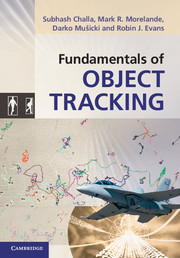Book contents
- Frontmatter
- Contents
- Preface
- 1 Introduction to object tracking
- 2 Filtering theory and non-maneuvering object tracking
- 3 Maneuvering object tracking
- 4 Single-object tracking in clutter
- 5 Single- and multiple-object tracking in clutter: object-existence-based approach
- 6 Multiple-object tracking in clutter: random-set-based approach
- 7 Bayesian smoothing algorithms for object tracking
- 8 Object tracking with time-delayed, out-of-sequence measurements
- 9 Practical object tracking
- Appendix A Mathematical and statistical preliminaries
- Appendix B Finite set statistics (FISST)
- Appendix C Pseudo-functions in object tracking
- References
- Index
Preface
Published online by Cambridge University Press: 07 September 2011
- Frontmatter
- Contents
- Preface
- 1 Introduction to object tracking
- 2 Filtering theory and non-maneuvering object tracking
- 3 Maneuvering object tracking
- 4 Single-object tracking in clutter
- 5 Single- and multiple-object tracking in clutter: object-existence-based approach
- 6 Multiple-object tracking in clutter: random-set-based approach
- 7 Bayesian smoothing algorithms for object tracking
- 8 Object tracking with time-delayed, out-of-sequence measurements
- 9 Practical object tracking
- Appendix A Mathematical and statistical preliminaries
- Appendix B Finite set statistics (FISST)
- Appendix C Pseudo-functions in object tracking
- References
- Index
Summary
Tracking the paths of moving objects is an activity with a long history. People in ancient societies used to track moving prey to hunt and feed their kith and kin, and invented ways to track the motion of stars for navigation purposes and to predict seasonal changes in their environments. Object tracking has been an essential technology for human survival and has significantly contributed to human progress.
In recent times, there has been an explosion in the use of object tracking technology in non-military applications. Object tracking algorithms have become an essential part of our daily lives. For example, GPS-based navigation is a daily tool of humankind. In this application a group of artificial satellites in outer space continuously locate the vehicles people drive and the object tracking algorithms within the GPS perform self-localization and enable us to enjoy a number of locationbased services, such as finding places of interest and route planning. Similarly, tracking of objects is used in a wide variety of contexts, such as airspace surveillance, satellite and space vehicle tracking, submarine and whale tracking and intelligent video surveillance. They are also used in autonomous robot navigation using lasers, stereo cameras and other proximity sensors, radiosonde-enabled balloon tracking for accurate weather predictions, and, more recently, in the study of cell biology to study cell fate under different chemical and environmental influences by tracking many kinds of cells, including lymphocyte and stem cells through multiple generations of birth and death.
- Type
- Chapter
- Information
- Fundamentals of Object Tracking , pp. ix - xiiPublisher: Cambridge University PressPrint publication year: 2011

